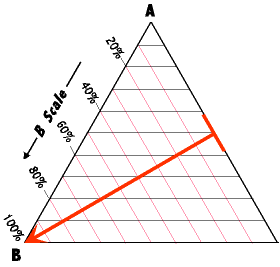

Rocks with isolated larger grains (phenocrysts) may yield distorted results.Gabbros, which can be further classified according to three modes (P/olivine/pyx+hbde).Rocks with M above 90: Ultramafic rocks have their own ternary diagram with three modes (olivine/pyroxene/hornblende).Rocks without enough silica to yield quartz: These instead contain feldspathoid minerals and have their own ternary diagram (F/A/P) if they are phaneritic.Aphanitic rocks: These are classified by chemical, not mineral content.A large proportion of igneous rocks aren't suited for this classification method:

The corresponding volcanic rock types are called rhyolitoids, but not very often. The middle three plutonic rock types - granite, granodiorite and tonalite - are together called granitoids. For plutonic rocks, gabbro and diorite have plagioclase with a calcium percentage (anorthite or An number) above and below 50, respectively. Which name to use depends on the composition of the plagioclase. Notice that the rock names at the P vertex are ambiguous. That's the official definition of the fields, and you can calculate your rock's position that way too. Notice that the lines that fan downward from the Q vertex are based on values, expressed as percentage, of the expression P/(A + P), meaning that each point on the line, regardless of the quartz content, has the same proportions of A to P.(Naturally, the number for A will also be there.) Read its name from the field in the diagram. The point where the lines for Q and P meet is your rock.That will be a line parallel to the left side. Measure along one of the sides, then draw a horizontal line at that point. Draw a line on the ternary diagram below to mark the value of Q, zero at the bottom and 100 at the top.Discard M and recalculate Q, A and P so that they add up to 100 - that is, normalize them.Determine the percentage, called the mode, of quartz (Q), alkali feldspar (A), plagioclase feldspar (P), and mafic minerals (M).In plutonic rocks, all of the minerals are crystallized into visible grains. The QAP ternary diagram is used to classify igneous rocks with visible mineral grains (phaneritic texture) from their feldspar and quartz content. (c) 2008 Andrew Alden, licensed to ( fair use policy) (when bundled with internet)CenturyLinkBasic Home Phone$23.34/mo.CoxVoice Premier$29.99/mo.FrontierVoice Service$10/mo.Igneous Rock Classification Diagrams Click the image for a larger version. How much does landline service cost? What companies offer landline phone services? ProvidersCheapest planStarting price*AT&TAT&T Phone Unlimited North America$22/mo. For example, AT&T charges $23 for a home residential line that includes a few additional basic features such as caller ID, call waiting and voicemail. How much is a landline phone per month? Typical costs: Basic phone service that includes unlimited local calls generally cost $15-$30 per month, depending on additional features. QHow much does a landline cost per month?A landline that includes unlimited local calls, but no long distance or international service typically costs $15-$30 each month.Additional features, such as long distance calls, call waiting, voicemail, or caller ID generally cost extra.


 0 kommentar(er)
0 kommentar(er)
